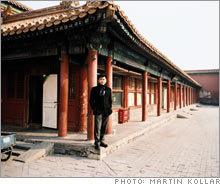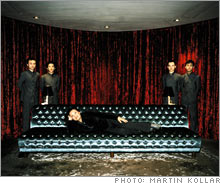China's new cultural revolutionAfter more than a decade embracing all things western, Chinese consumers are turning more, well ... Chinese. Time to rethink the China strategy?(Fortune Magazine) -- On a crowded Sunday morning inside the Forbidden City, one of China's best-known TV anchors is warily eyeing a squat, slope-roofed building that for five centuries housed the office of the emperor's physicians. Its thick red pillars are in need of paint. Its windows are grimy with soot from Beijing's notoriously bad air. Only the crowd at the door gives a hint of what's inside: a Starbucks. The coffee chain, which opened this outpost seven years ago, has already caved in to the sensitivities of being located in this epicenter of Chinese culture. It has removed its familiar green sign from the entrance. But the counter can still easily be found by tracing the streams of customers toting Starbucks cups as they step through the passageways.
"This is wrong," says Rui Chenggang, drawing stares from passersby who know him as China's Lou Dobbs, the host of a nightly TV show called "BizChina." Rui is neither a narrow-minded nationalist, he quickly adds, nor anti-Starbucks. He's just pro-China and resolutely against what he sees as the mindless grasping at Western influences that followed China's opening to the world. Rui's blog, which features a letter he sent to Starbucks CEO Jim Donald, has stirred a populist movement to oust the store from the Forbidden City. And it has put Starbucks (Charts, Fortune 500) at the center of a broader phenomenon taking hold in China. "Once we were too eager to show we were part of the world," says Rui. "But things are changing. We need to preserve our own cultural heritage." Seven years ago China had just agreed to join the World Trade Organization and was eager to embrace globalization in its mad rush to modernize. Western stuff was hot. Chinese stuff was not. The trendiest hangouts, the places where China's hipsters and elites would gather, like Shanghai's M on the Bund, served Western food, relegating Chinese high cuisine to dowdy formal banquets. Fast-food outlets such as KFC began popping up everywhere. Luxury retailers piled in too: the first Tiffany's in 2001, Paul Smith and Moschino in 2002, Armani and Louis Vuitton flagship stores in 2004 and 2005. Western companies and their products were viewed as offering superior quality, technology and prestige. Newly wealthy Chinese, wanting to show off their success with displays of affluence, did what was natural for nouveaux riches everywhere: They bought expensive Western products and showed them off. Chinese Renaissance But there's a not-so-subtle shift happening in China. After more than a decade of embracing all things Western, Chinese are turning to things Chinese. Today, mainland companies are no longer churning out only shoddy goods. They are producing products that in the eyes of consumers rival or are better than those in the West. A survey by McKinsey of 800 teenagers found that 88 percent trust Chinese brands, compared with 65 percent who say the same of foreign ones. The reasons are many, including a spate of stories about safety issues involving foreign consumer products and food. But the improved quality of Chinese brands is also a factor. The brands aren't well-known outside China - yet. But they include Haier appliances, Aigo electronics and Geely and Chery cars. These days China has world-class fashion designers whose modern takes on mandarin collars and silk designs of bygone dynasties are worn proudly to parties by chic Chinese and incorporated into streetwear by the middle class. Chinese modern art is fetching record prices. Traditional patterns and styles are making their way into modern furniture, architecture and design. The teachings of Confucius, the practice of traditional medicine, and worship at Buddhist temples are experiencing renewed popularity - and receiving tacit if not outright government support. Among Shanghainese women, the short hairstyles of an earlier era have become fashionable again, replacing a decade of Jennifer Aniston locks copied from Friends. And the most hip restaurant in China is, finally, Chinese - the Lan Club in Beijing, owned by Zhang Lan, founder of the successful South Beauty restaurant chain, which features Sichuan dishes. "Chinese cuisine always had everything, nutrition- and taste-wise, but what was lacking was the packaging," says Zhang. "People in China didn't know how to present it. I have changed that." A recent photo spread of her culinary palace in Vogue China, which also featured a Chinese Allure section on fashions with Chinese characteristics, was headlined SEE AND BE SEEN. Nobody except foreigners on expense accounts is seen at M on the Bund anymore. So now it's Chineseness that's hot. "People are increasingly proud of their country and proud of the progress of the country," says brand consultant Martin Roll, author of Asian Brand Strategy. "As society moves on and becomes more sophisticated, there comes a taste for nationalism, for what is local. We're going to see Western brands have more and more competition in China." Sinofication presents a challenge most Western companies have yet to come to terms with. While many have set up R&D centers in China, their experiments have mostly resulted in minor tweaks to products developed abroad. The major innovations being worked on in China have yet to hit the market. And so far there's little evidence that Western brands are suffering - after all, an economy rising at 11 percent lifts all boats. But increasingly, Chinese companies are benefiting from nationalist feeling, gaining market share in sectors such as passenger cars and consumer electronics that were previously the exclusive province of foreign companies. The 2008 Olympics in Beijing will likely add more kindling to this nationalist spark. The government is also making an effort to reduce dependence on foreigners for manufacturing and technology transfer. Preferential tax rates for foreign companies - now at 15 percent, compared with 33 percent for Chinese - are set to end this year. And last fall the Communist Party Congress endorsed a push for "Chinese innovation" by doubling the amount spent on R&D. To help reduce China's dependence on foreign companies, Beijing has set a target of 60 percent for domestic car brands sold by 2010, largely by providing consumer financing and incentives. Today, Chinese-branded cars claim little more than 20 percent of a market dominated by Buicks, Volkswagens and Toyotas. But in March, Chery sold more cars in China than any other automaker. Foreigners also are being kept from buying major stakes in industries deemed sensitive to government interests, including cement, soybeans and finance. While such moves are viewed as retaliation for the U.S. refusal to let China National Offshore Oil Corp. buy Unocal in 2005, they have been strengthened by economic nationalism and entrenched as policy. |
Sponsors
|



